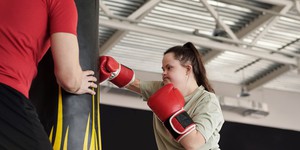Abstract
Do you like to watch the Olympics and see new world records get set? Have you ever wondered how fast you'd need to go to achieve that world record? Well, in this sports science fair project, you'll find out how to compute speeds needed to achieve world records. Not only that, but you'll learn what speed is, and how to measure it in almost anything that moves! So head for the track, you're on a search for speed!Summary
Kristin Strong, Science Buddies
Objective
To learn how to measure speed and to compare the speeds of athletes in different sporting events.
Introduction
A world track record! It's always exciting to watch! You see the winning time flashed on your TV, but just how fast was that runner going, on average? What was his or her speed? In this science fair project, you'll learn how to find out the speed of not only world-class runners, but of other athletes and neighborhood bike and skateboard riders, too. In fact, once you understand what speed is, you'll be able to measure the speed of just about anything that moves, including a river.
Speed is one of the most common measurements that people take. It tells you how the position of something is changing with respect to time. When you hear, for example, that a car is going at a speed of 25 miles per hour, (mph) it means that if the car kept going at this same speed, in 1 hour (h) it would have gone 25 miles. Miles per hour is a common measure of speed in the United States and is known as the English system, but in other countries and in science and engineering, the metric system is often used instead. The units of speed in the metric system are meters per second, (m/s) or for cars, kilometers per hour (km/h).
The word per in all these units tell you that you are going to use division to calculate speed. You measure the distance something has traveled and divide it by the time it took to travel that distance. That gives you speed. You can then transform your speed calculation into whatever units you want to look at by using standard conversion tables.
Equation 1:
- Speed is in meters/second (m/s) in the metric system.
- Distance is in meters (m) in the metric system.
- Time is in seconds (s) in the metric system.
Here's an example of how to calculate speed, using Equation 1. The world record in the men's 800-m track and field is event is 1 minute (min) and 41 seconds (sec). To get the runner's speed in miles per hour, follow these three steps:
- Convert the winning time to seconds: 1 min and 41 sec is the same as 101 sec total.
- Next, to calculate the speed, use Equation 1 and divide the total distance, 800 m, by 101 sec, and that gives you 7.92 m/s.
- The final step (which is optional, but a way to put it in units that might be more familiar to you) is to convert meters per second into miles per hour. To do this, find the conversion tables for seconds to hours, and meters to miles. If you look this up, you see that there are 3600 sec in 1 h, and there are 1609.34 m in 1 mile. You can then convert from meters per second to miles per hour using Equation 2.
Equation 2:
| ( | 7.92 meters 1 sec |
) | × | ( | 3600 sec 1 hour |
) | × | ( | 1 mile 1609.34 meters |
) | = | ( | 17.7 miles 1 hour |
) | = 17.7 miles per hour |
Do you see how the meters and seconds units cancel out, leaving behind miles per hour? So, now you know, to run the 800-m track event in world record time, your speed must average 17.7 mph!
Now it's time to set up your own neighborhood races with bikes, skateboards, scooters, or your own two feet. How many miles per hour can you go at short distances? How about over longer distances? Can you get close to world record running speeds when you're riding your bike? Let the racing begin!
Terms and Concepts
- Speed
- Position
- Miles per hour (m/h)
- Meters per second (m/s)
- Kilometers per hour (km/h)
- Division
- Conversion tables
- Linear
Questions
- What is speed?
- What are the units of speed?
- How do you measure speed?
- How do you calculate speed?
- How do you convert speed from one set of units to another?
Bibliography
This source shows tables of world record performances for men and women in track and field events:
- World Athletics. (2008). Seasons Top Lists. Retrieved August 14, 2020.
This science fair project was inspired by this resource:
- TPT. (2006). Kayaking by Jenny, Simi, and Danny. DragonflyTV, Twin Cities Public Television. Retrieved June 27, 2008.
This source provides conversion tables between metric and English units:
- Wikipedia Contributors. (2008, June 27). Conversion of units. Wikipedia: The Free Encyclopedia. Retrieved June 27, 2008.
Materials and Equipment
- Lab notebook
- Stopwatch
- Helper
- Personal computer with internet access
You need a way to measure distance.
- An ideal place to measure distance is a school sports track, which is often marked out for you. Typically, one lap around on the inside lane is 400 m (or 440 yards, approximately one-quarter of a mile).
- If you are going to be testing speeds over short distances on a sidewalk or empty parking lot, you can use a measuring tape to mark out a certain number of feet.
- Your family's car has an odometer, which can be used to measure out a distance in a safe location for testing.
- Some roads have mileage markers that you can use to tell how far you have gone, but again, you must make sure the road is a safe and appropriate spot for testing.
- Some cities have Olympic-sized community pools for public use. One length of the pool is 50 m.
You need a way to measure time.
- A stopwatch is ideal if you are measuring sprints or shorter distance races.
- A regular digital watch, or watch with a second hand is an acceptable alternative for measuring speeds over longer distances.
Experimental Procedure
- Determine the sports you would like to speed-test and write them down in a data table in your lab notebook. Examples are: swimming, walking, skipping, jumping, running, bicycling, skateboarding, rollerblading, ice speed skating, sledding, skiing, or riding your scooter.
- Determine the distances you would like to speed-test for each sport. If you've chosen several sports, you could choose the same distance for each sport and see how speed varies between sports, as shown in the example Personal Speed Data Table below. If you have just one or two sports you would like to test, then you could choose short and long distances for each sport, and see how your speed changes as the distance increases. Write down the distances you've decided to test in the data table in your lab notebook.
- Measure out the distances you have decided to test using one of the methods suggested above.
-
Having your helper use a stopwatch or regular watch, time and record how fast you can do each event in your Personal Speed Data Table three times. If the distance you are testing is relatively long, you might have to wait several hours, or even a day between trials to allow yourself time to recover from the previous trial. For shorter distances, you might be able to recover from a trial in several minutes. Always make sure you are wearing appropriate safety gear, like a helmet, especially when you are testing a sport with wheels! Do not hold the stopwatch yourself as it could cause an accident. Always have a helper keep track of the time.
Personal Speed Data Table Event Distance Trial 1 Time
(sec)Trial 2 Time
(sec)Trial 3 Time
(sec)Trial 1 Speed (m/s) Trial 2 Speed (m/s) Trial 3 Speed (m/s) Average Speed (m/s) Average Speed (mph) Swimming 200 m (example) Walking 200 m Running 200 m Skateboarding 200 m Riding a Scooter 200 m Bicycling 200 m
-
For each event, calculate and record the speed for each trial by dividing the event distance in meters by the time for the trial in seconds.
- Determine the sports you would like to speed-test and write them down in a data table in your lab notebook. Examples are: swimming, walking, skipping, jumping, running, bicycling, skateboarding, rollerblading, ice speed skating, sledding, skiing, or riding your scooter.
- Determine the distances you would like to speed-test for each sport. If you've chosen several sports, you could choose the same distance for each sport and see how speed varies between sports, as shown in the example Personal Speed Data Table below. If you have just one or two sports you would like to test, then you could choose short and long distances for each sport, and see how your speed changes as the distance increases. Write down the distances you've decided to test in the data table in your lab notebook.
- Measure out the distances you have decided to test using one of the methods suggested above.
-
Having your helper use a stopwatch or regular watch, time and record how fast you can do each event in your Personal Speed Data Table three times. If the distance you are testing is relatively long, you might have to wait several hours, or even a day between trials to allow yourself time to recover from the previous trial. For shorter distances, you might be able to recover from a trial in several minutes. Always make sure you are wearing appropriate safety gear, like a helmet, especially when you are testing a sport with wheels! Do not hold the stopwatch yourself as it could cause an accident. Always have a helper keep track of the time.
Personal Speed Data Table Event Distance Trial 1 Time
(sec)Trial 2 Time
(sec)Trial 3 Time
(sec)Trial 1 Speed (m/s) Trial 2 Speed (m/s) Trial 3 Speed (m/s) Average Speed (m/s) Average Speed (mph) Swimming 200 m (example) Walking 200 m Running 200 m Skateboarding 200 m Riding a Scooter 200 m Bicycling 200 m
- For each event, calculate and record the speed for each trial by dividing the event distance in meters by the time for the trial in seconds.
- For each event, calculate and record the average speed in meters per second by adding together the speeds of your three trials and dividing by 3.
- For each event, convert the average speed in meters per second into an average speed in miles per hour, as shown in the example of Equation 2 in the Introduction.
-
Now go to the International Association of Athletics Federations website to find
world record performances for track and field events. Fill out the World Record Data Table using world-record times for men or women.
World Records Speed Data Table Event Distance World Record Speed (m/s) Speed (mph) 100 m track 100 m 200 m track 200 m 400 m track 400 m 800 m track 800 m 1600 m track 1600 m 3200 m track 3200 m Half Marathon 13.1 miles Marathon 26.2 miles 100-mile Ultra-Marathon 100 miles
- Examine the World Records Speed Data Table and describe what happens to speed as the distance increases. Plot the distance on the x-axis and the speed on the y-axis. Is the distance-speed relationship linear (in a straight line)?
-
Examine your own Personal Speed Data Table.
- If you tested multiple sports at the same distance, which sport was the fastest for you at that distance? Which was the slowest? Rank the sports you tested from slowest to fastest? Were there any surprises? Were you able to approach any of the speeds that you calculated in the World Records Speed Data Table?
- If you tested one or two sports at multiple distances, repeat step 9 using your Personal Speed Data Table, rather than the World Records Speed Data Table.
- For each event, calculate and record the average speed in meters per second by adding together the speeds of your three trials and dividing by 3.
- For each event, convert the average speed in meters per second into an average speed in miles per hour, as shown in the example of Equation 2 in the Introduction.
-
Now go to the International Association of Athletics Federations website to find
world record performances for track and field events. Fill out the World Record Data Table using world-record times for men or women.
World Records Speed Data Table Event Distance World Record Speed (m/s) Speed (mph) 100 m track 100 m 200 m track 200 m 400 m track 400 m 800 m track 800 m 1600 m track 1600 m 3200 m track 3200 m Half Marathon 13.1 miles Marathon 26.2 miles 100-mile Ultra-Marathon 100 miles
- Examine the World Records Speed Data Table and describe what happens to speed as the distance increases. Plot the distance on the x-axis and the speed on the y-axis. Is the distance-speed relationship linear (in a straight line)?
-
Examine your own Personal Speed Data Table.
- If you tested multiple sports at the same distance, which sport was the fastest for you at that distance? Which was the slowest? Rank the sports you tested from slowest to fastest? Were there any surprises? Were you able to approach any of the speeds that you calculated in the World Records Speed Data Table?
- If you tested one or two sports at multiple distances, repeat step 9 using your Personal Speed Data Table, rather than the World Records Speed Data Table.
Ask an Expert
Variations
- Compare the speeds of elite athletes, by age, for the same sporting event. At what age do runners typically reach their peak for the event you chose to investigate? For the same sport, does the age at which an athlete reaches his or her peak change with distance?
- Compare the speeds of elite athletes by gender for different sporting events. In what events and at what distances do men have an advantage, and in what events and distances do women have an advantage?
- Compare the speeds of the fastest humans with those of several types of animals. In general, are four legs faster than two? Does standing upright offer any sporting advantage? What happens at distances?
Careers
If you like this project, you might enjoy exploring these related careers:









